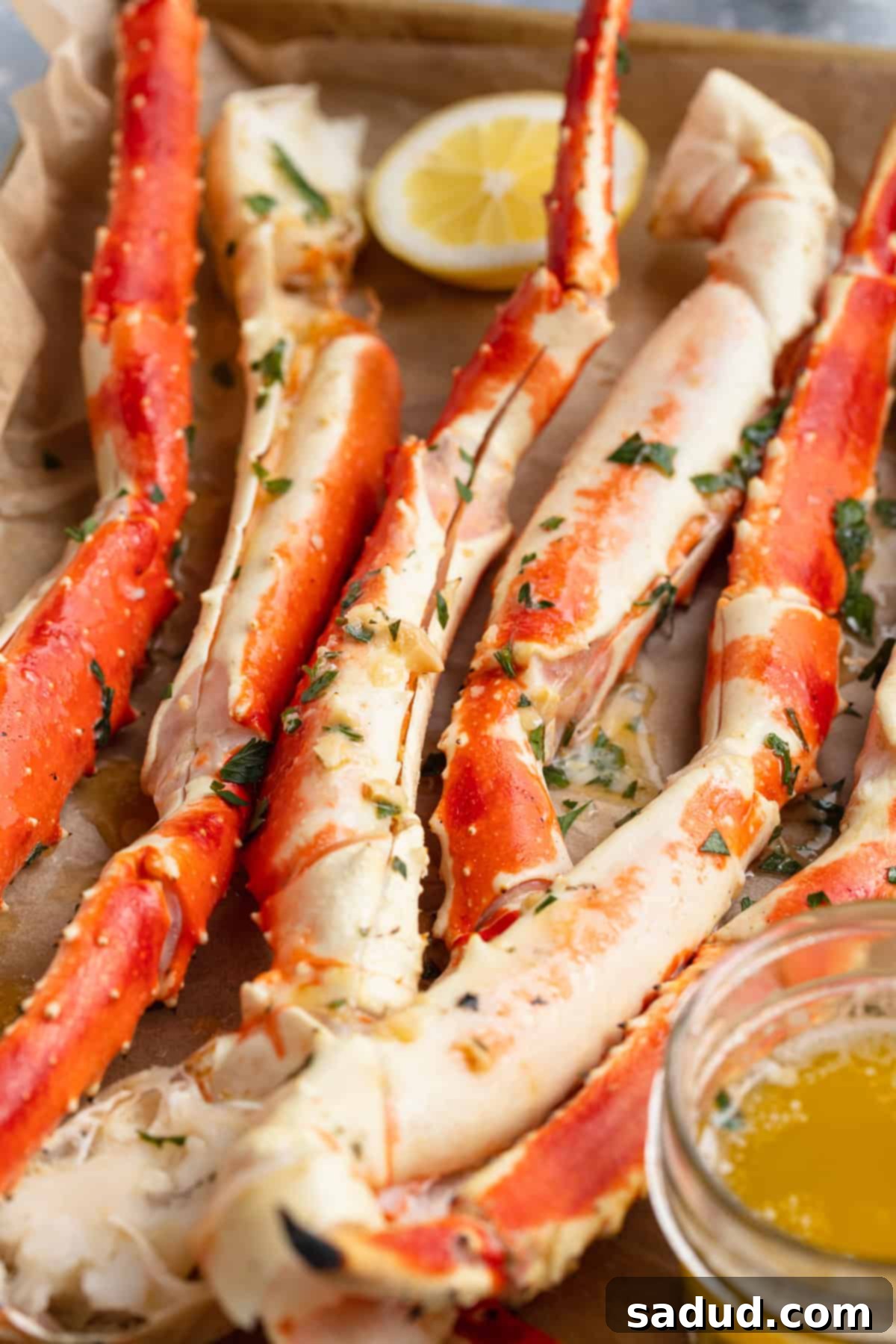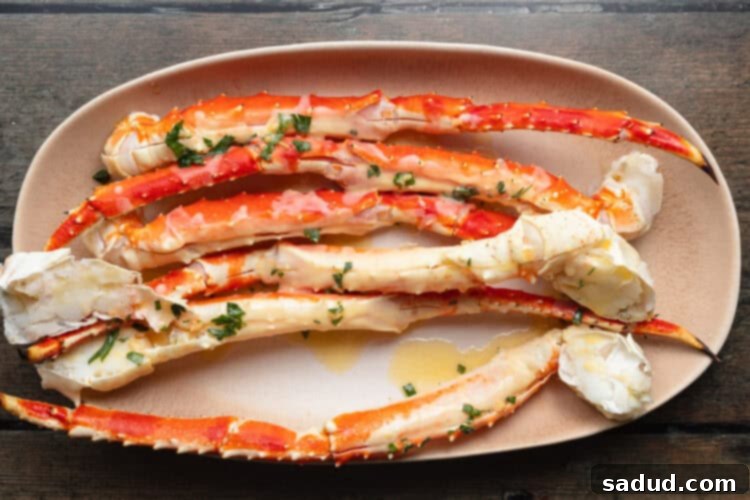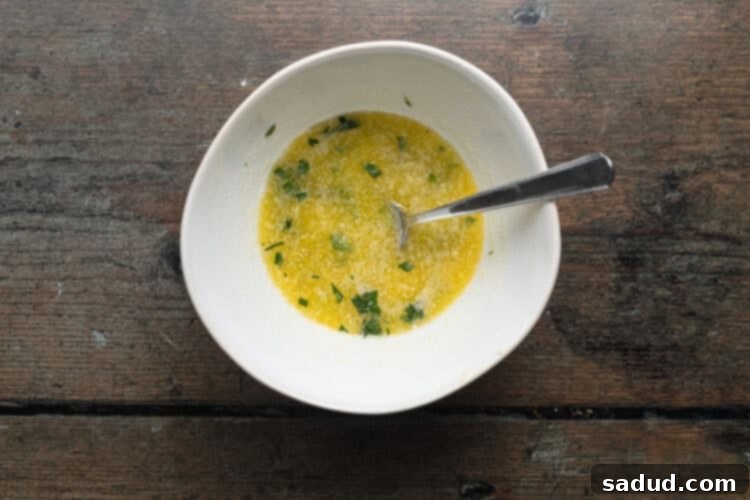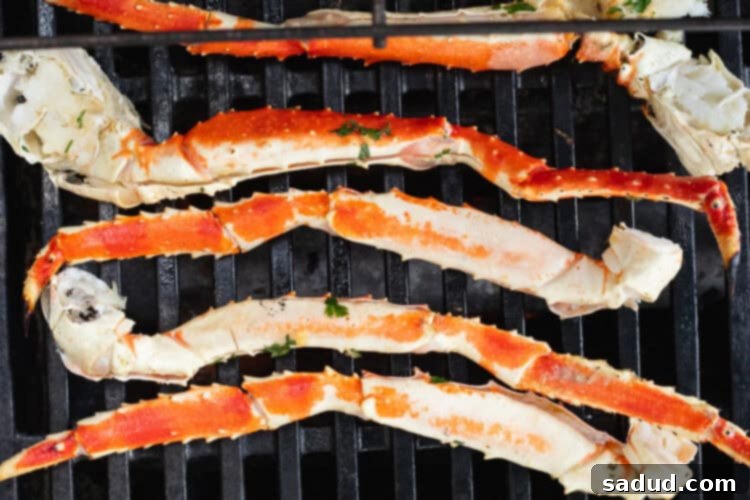Perfectly Grilled Crab Legs with Irresistible Garlic Butter: Your Ultimate Summer Seafood Recipe
Transform your summer dining with perfectly cooked grilled crab legs – a simple, yet utterly delicious meal ready in just 10 minutes! Paired with an incredibly easy garlic butter sauce, this dish is not only a fantastic low-carb, keto-friendly, and gluten-free option but also easily adaptable for Whole30 and Paleo diets. It’s a real treat that brings the gourmet seafood experience right to your backyard grill, making any gathering feel extra special without hours of preparation.
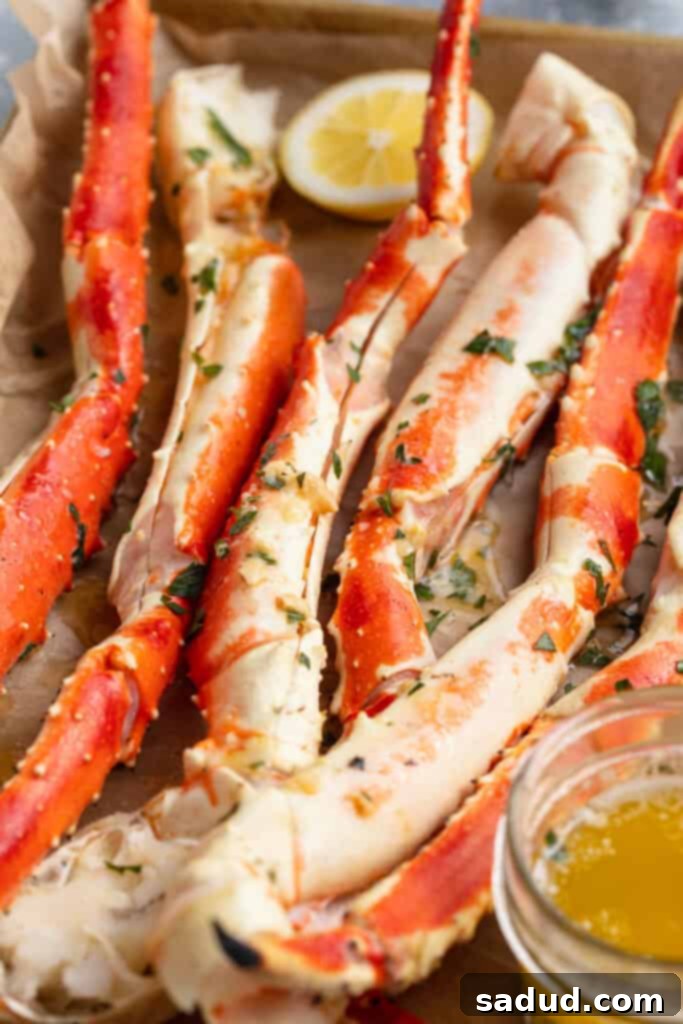
Why You’ll Absolutely Love This Grilled Crab Leg Recipe
There’s something truly special about grilled crab legs, and this recipe highlights all the best reasons to add them to your rotation. From the incredibly straightforward cooking process to the explosion of flavors, here’s why this dish is bound to become a new favorite:
- Unbelievably Easy Grilling: Many people assume grilling crab legs is complicated, but it’s quite the opposite! Most crab legs are sold pre-cooked and frozen, which means your main tasks are defrosting and a quick grill. While it requires a bit more hands-on attention than, say, an Instant Pot method, the process is still remarkably simple and yields spectacular results. You’ll be amazed at how quickly you can have a restaurant-quality meal on the table.
- A Flavor Profile That Can’t Be Beat: Grilling imbues the sweet, tender crab meat with an exquisite smoky depth that steaming or boiling simply cannot replicate. This char from the grill adds a new dimension of flavor that pairs perfectly with a bright, herbaceous garlic butter sauce. The combination of succulent crab, rich butter, pungent garlic, and fresh herbs creates an unforgettable taste experience.
- Nutritious and Diet-Friendly: Beyond being incredibly tasty, crab legs are a powerhouse of nutrition. They are exceptionally high in lean protein, very low in carbohydrates, and packed with essential vitamins and minerals. If you’re following a keto, low-carb, or gluten-free diet, this recipe is an outstanding and delicious alternative to more common proteins like chicken or ground beef, offering a luxurious meal that aligns with your health goals.
- The Ultimate Summer Showstopper: Grill season calls for classics, but why not elevate your menu? While ribs, burgers, corn on the cob, potatoes, and chicken are summer staples, imagine presenting a platter of beautifully grilled crab legs! It’s an unexpected and impressive dish that will undoubtedly impress your guests and make your summer cookout truly memorable.
Expert Tips for Grilling Perfect Crab Legs
Achieving perfectly grilled crab legs is straightforward with a few key techniques. Follow these expert tips to ensure your crab is tender, flavorful, and a true culinary delight every time:
- Portion Sizes: When serving grilled crab legs as the main course, plan for roughly 1 ½ pounds of crab legs per person. It’s crucial to remember that this refers to the weight of the legs in their shells, not the edible meat. Crab shells contribute significantly to the total weight, and you’ll typically yield about ½ to ¾ pound of actual crab meat from one pound of legs. Adjust your purchase accordingly to ensure everyone gets a generous, satisfying portion.
- Crab Varieties: While this recipe is designed using king crab legs, the instructions and cooking times are equally applicable to Dungeness and snow crab legs. These alternatives are often more budget-friendly than king crab, making them an excellent choice, especially when feeding a larger crowd without compromising on flavor or quality.
- Thorough Defrosting is Key: If you’re using frozen crab legs, proper defrosting before grilling is absolutely essential for even cooking and optimal texture. Never attempt to grill them while still frozen. The best method is to transfer them to the refrigerator overnight. For a quicker defrost, place the crab legs in a sealed plastic bag (or ensure they’re in one) to prevent water from entering, press out any excess air, and submerge the bag in a sink full of cold water for 25-30 minutes, changing the water every 10-15 minutes. Avoid using hot or warm water, as this can start to cook the delicate crab meat prematurely, resulting in a rubbery texture.
- Avoid Overcooking: Crab meat cooks very quickly, and overcooking is the fastest way to ruin its delicate texture, turning it tough and rubbery. Keep a close eye on your crab legs while they’re on the grill. They should be a vibrant reddish-orange color with white, opaque meat. If the color shifts from reddish-orange to a dull pink, you’ve likely overdone it. The goal is to heat them through, infusing them with smoky flavor, without drying them out.
- Splitting the Shells: Don’t skip the step of cutting lengthwise through the white part of the leg shells. This crucial step not only makes the crab meat much easier to access for eating but also allows the delicious garlic butter sauce and the smoky grill flavors to penetrate the meat more effectively, maximizing every bite.
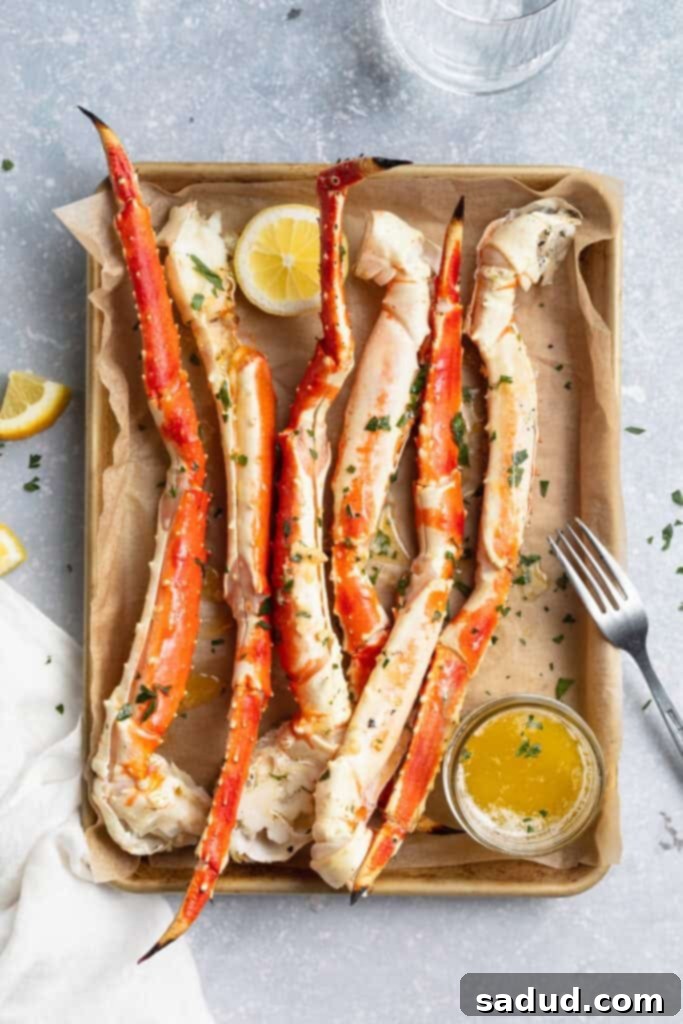
Selecting the Best Crab Legs for Grilling
The quality of your crab legs will significantly impact the final dish. When shopping for crab, whether at your local seafood market or grocery store, prioritize freshness and quality. Look for crab legs that are bright in color and have no strong, fishy odor. Frozen crab legs are perfectly acceptable and often more accessible, but ensure they are well-packaged to prevent freezer burn. King, Snow, and Dungeness crab are all excellent choices for grilling, each offering a slightly different texture and sweetness profile.
Crafting the Perfect Garlic-Butter Sauce
The garlic-butter sauce is more than just a condiment; it’s an integral part of the grilled crab leg experience. The recipe calls for a simple yet potent combination of melted butter, fresh parsley, minced garlic, and lemon juice. The lemon juice adds a crucial zing that cuts through the richness of the butter and enhances the natural sweetness of the crab. For variations, consider adding a pinch of red pepper flakes for a subtle kick, a dash of Old Bay seasoning for a classic seafood flavor, or some fresh dill for an earthy, aromatic twist. Ensure your butter is melted but not boiling to maintain its delicate flavor and consistency for dipping and basting.
Delicious Recipes To Pair With Grilled Crab Legs
To complete your seafood feast, consider serving your grilled crab legs with these delightful side dishes:
- Instant Pot Cornbread
- Chick-Fil-A Coleslaw
- Roasted Chili Corn Salsa
- Southern Smothered Potatoes
- Bone-In Ribeye With Garlic-Herb Butter (for a surf-and-turf masterpiece!)
Serving Suggestions and Presentation
Once your crab legs are grilled to perfection, presentation can make the meal even more appealing. Arrange the split crab legs on a large platter, perhaps garnished with fresh lemon wedges and extra parsley. Serve the reserved garlic-butter sauce in small individual ramekins for dipping. This allows each person to enjoy as much sauce as they desire. Don’t forget seafood crackers and small forks to help extract all that delicious meat! For a more casual affair, consider a newspaper-lined table for an authentic crab boil feel.
Storage and Reheating Leftover Crab Legs
While grilled crab legs are best enjoyed fresh off the grill, sometimes you might have leftovers. Store any remaining cooked crab meat (removed from shells for easier storage) in an airtight container in the refrigerator for up to 2-3 days. To reheat, gently steam the crab meat for a few minutes until warmed through, or briefly sauté in a pan with a little butter. Avoid microwaving, as it can make the crab rubbery. You can also enjoy cold crab meat in salads or seafood rolls.
If you loved this recipe as much as we did, don’t forget to leave us a review below. ★ Follow Easy Healthy Recipes on Pinterest, Facebook, and Instagram, too!
For more delicious recipes, visit our sister sites, 40 Aprons and Easy Cheap Recipes.
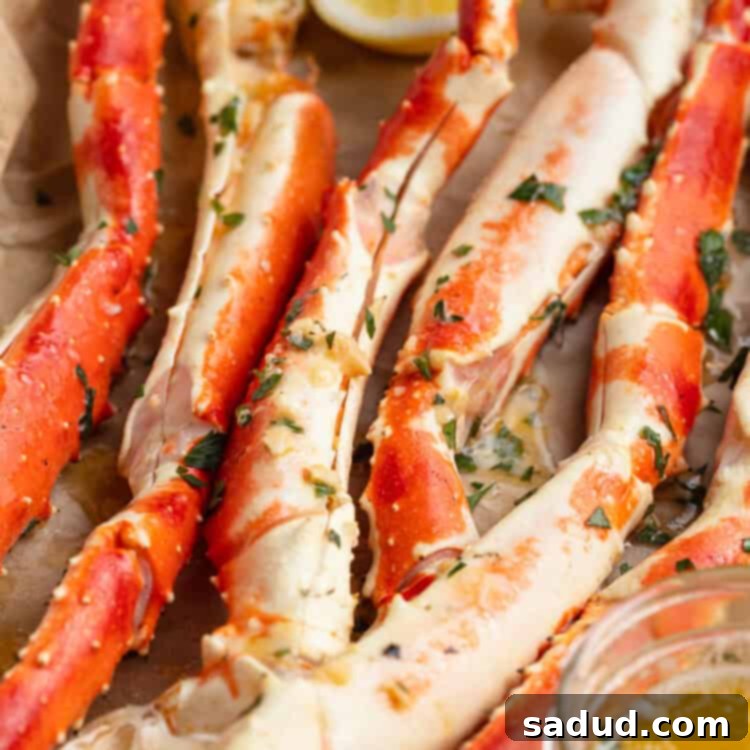
Grilled Crab Legs with Garlic-Butter Sauce
 Sam Guarnieri
Sam Guarnieri
Print
SaveSaved!
Ingredients
For the Crab Legs
- 3 pounds king crab legs defrosted if frozen (see notes for defrosting instructions)
For the Garlic-Butter Sauce
- ½ cup butter melted but not boiling (use ghee or dairy-free butter for Whole30/Paleo/Dairy-Free options)
- ¼ cup chopped fresh parsley
- 3 cloves garlic minced
- 1 tablespoon fresh lemon juice
- 1 pinch salt to taste
- 1 pinch freshly cracked black pepper to taste
Equipment
-
Grill
-
Kitchen scissors
-
Small bowl
-
whisk
-
Spoon or basting brush
Instructions
-
Preheat your grill to a medium-high heat, aiming for approximately 375° to 450° Fahrenheit. Using sturdy kitchen scissors, carefully cut lengthwise through the soft, white underside of each crab leg shell. This will split the shell open, exposing the succulent crab meat without fully detaching it from the shell. Set the prepared crab legs aside.

-
In a small bowl, combine the melted butter (ensuring it’s melted but not boiling hot), the freshly chopped parsley, finely minced garlic, and the fresh lemon juice. Add a pinch of salt and freshly cracked black pepper to taste. Whisk these ingredients vigorously until they are thoroughly combined and emulsified into a fragrant, smooth sauce.

-
With a spoon or a basting brush, generously drizzle approximately half of the prepared garlic-butter sauce directly over the exposed crab meat inside the split legs. This initial application allows the flavors to seep into the meat as it grills. Make sure to reserve the remaining half of the butter sauce; it will be used for serving and dipping.
-
Carefully place the seasoned crab legs directly onto the preheated grill grates, ensuring the split-shell side is facing upwards. Close the grill lid to allow for even heat distribution and grill the crab legs over direct heat for approximately 7 minutes. After 7 minutes, check their doneness. Continue grilling as needed, checking frequently, until the crab legs have turned a uniform reddish-orange color and the meat is opaque and pearly white throughout. The total grilling time should not exceed 10 minutes to prevent toughness.

-
Once cooked, carefully remove the grilled crab legs from the grill using tongs. Serve them immediately while hot, accompanied by the reserved garlic-butter sauce for dipping, and any desired side dishes to complete your delectable meal.
Notes
- You may occasionally find pre-split crab legs at your seafood counter, which saves a step. If not, don’t skip the cutting step described in the instructions – it’s crucial for both easy eating and ensuring the crab meat absorbs the maximum amount of flavor from the grill and the butter sauce.
- As a general guideline, 1 pound of king crab legs typically yields approximately ½ to ¾ pounds of actual edible crab meat. If these grilled crab legs are intended to be the primary protein for your meal, a good rule of thumb is to purchase 1 ½ pounds of crab legs per person. If you’re serving them as a luxurious side dish alongside other proteins, you can typically scale back to just 1 pound of legs per person.
- This recipe is versatile! Dungeness and snow crab legs can be used interchangeably with king crab legs. The preparation instructions, grilling techniques, and recommended cooking times remain exactly the same regardless of the crab type, ensuring consistent, delicious results.
- To make this recipe Whole30/Paleo compliant: Simply substitute regular butter with clarified butter, also known as ghee. Ghee provides a rich, buttery flavor while adhering to these dietary guidelines.
- To make this recipe Dairy-Free: Opt for a high-quality dairy-free butter alternative. Many plant-based butters are available that melt beautifully and provide a similar rich texture and flavor profile to traditional butter, making this dish accessible to those with dairy sensitivities.
Nutrition Information
Number of total servings shown is approximate. Actual number of servings will depend on your preferred portion sizes.
Nutritional values shown are general guidelines and reflect information for 1 serving using the ingredients listed, not including any optional ingredients. Actual macros may vary slightly depending on specific brands and types of ingredients used.
To determine the weight of one serving, prepare the recipe as instructed. Weigh the finished recipe, then divide the weight of the finished recipe (not including the weight of the container the food is in) by the desired number of servings. Result will be the weight of one serving.
